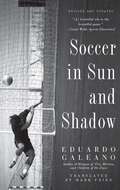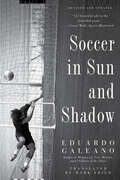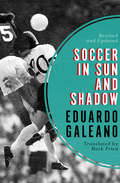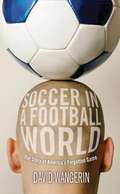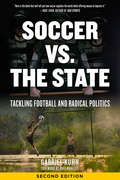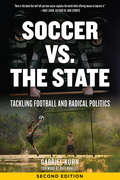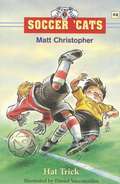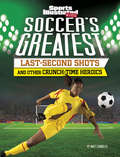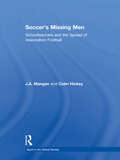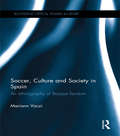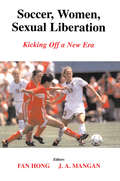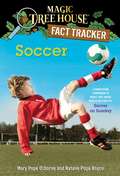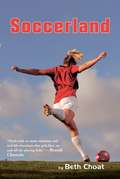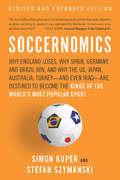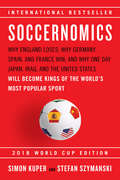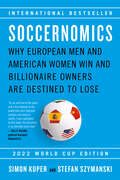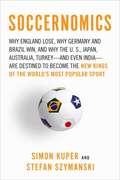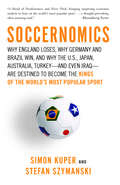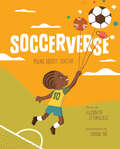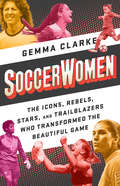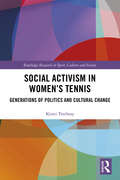- Table View
- List View
Soccer in Sun and Shadow
by Eduardo GaleanoIn this witty and rebellious history of world soccer, award-winning writer Eduardo Galeano searches for the styles of play, players, and goals that express the unique personality of certain times and places. <P><P>In Soccer in Sun and Shadow, Galeano takes us to ancient China, where engravings from the Ming period show a ball that could have been designed by Adidas to Victorian England, where gentlemen codified the rules that we still play by today and to Latin America, where the "crazy English" spread the game only to find it creolized by the locals. <P>All the greats-Pelé, Di Stéfano, Cruyff, Eusébio, Puskás, Gullit, Baggio, Beckenbauer- have joyous cameos in this book. yet soccer, Galeano cautions, "is a pleasure that hurts." Thus there is also heartbreak and madness. Galeano tells of the suicide of Uruguayan player Abdón Porte, who shot himself in the center circle of the Nacional's stadium; of the Argentine manager who wouldn't let his team eat chicken because it would bring bad luck; and of scandal-riven Diego Maradona whose real crime, Galeano suggests, was always "the sin of being the best." <P>Soccer is a game that bureaucrats try to dull and the powerful try to manipulate, but it retains its magic because it remains a bewitching game-"a feast for the eyes ... and a joy for the body that plays it"-exquisitely rendered in the magical stories of Soccer in Sun and Shadow.
Soccer in Sun and Shadow
by Eduardo GaleanoIn this witty and rebellious history of world soccer, award-winning writer Eduardo Galeano searches for the styles of play, players, and goals that express the unique personality of certain times and places. In Soccer in Sun and Shadow, Galeano takes us to ancient China, where engravings from the Ming period show a ball that could have been designed by Adidas to Victorian England, where gentlemen codified the rules that we still play by today and to Latin America, where the #147;crazy English” spread the game only to find it creolized by the locals. All the greats#151;Pelé, Di Stéfano, Cruyff, Eusébio, Puskás, Gullit, Baggio, Beckenbauer#151; have joyous cameos in this book. yet soccer, Galeano cautions, #147;is a pleasure that hurts. ” Thus there is also heartbreak and madness. Galeano tells of the suicide of Uruguayan player Abdón Porte, who shot himself in the center circle of the Nacional’s stadium; of the Argentine manager who wouldn’t let his team eat chicken because it would bring bad luck; and of scandal-riven Diego Maradona whose real crime, Galeano suggests, was always #147;the sin of being the best. ” Soccer is a game that bureaucrats try to dull and the powerful try to manipulate, but it retains its magic because it remains a bewitching game#151;#147;a feast for the eyes . . . and a joy for the body that plays it”#151;exquisitely rendered in the magical stories of Soccer in Sun and Shadow.
Soccer in Sun and Shadow
by Eduardo GaleanoOne of the greatest, magical, and most lyrical accounts of the beautiful gameIn this witty and rebellious history of world soccer, award-winning writer Eduardo Galeano searches for the styles of play, players, and goals that express the unique personality of certain times and places. In Soccer in Sun and Shadow, Galeano takes us to ancient China, where engravings from the Ming period show a ball that could have been designed by Adidas to Victorian England, where gentlemen codified the rules that we still play by today and to Latin America, where the &“crazy English&” spread the game only to find it creolized by the locals.All the greats—Pelé, Di Stéfano, Cruyff, Eusébio, Puskás, Gullit, Baggio, Beckenbauer— have joyous cameos in this book. yet soccer, Galeano cautions, &“is a pleasure that hurts.&” Thus there is also heartbreak and madness. Galeano tells of the suicide of Uruguayan player Abdón Porte, who shot himself in the center circle of the Nacional's stadium; of the Argentine manager who wouldn't let his team eat chicken because it would bring bad luck; and of scandal-riven Diego Maradona whose real crime, Galeano suggests, was always &“the sin of being the best.&”Soccer is a game that bureaucrats try to dull and the powerful try to manipulate, but it retains its magic because it remains a bewitching game—&“a feast for the eyes ... and a joy for the body that plays it&”—exquisitely rendered in the magical stories of Soccer in Sun and Shadow.
Soccer in Sun and Shadow
by Eduardo GaleanoOne of Sports Illustrated&’s Top 100 Sports Books of All Time—a history of soccer that &“stands out like Pelé on a field of second-stringers&” (The New Yorker). The beautiful game deserves a beautiful book, and Eduardo Galeano—one of Latin America&’s most acclaimed authors—has written it. From Aztec champions sacrificed to appease the gods, to the goals that were literally scored into wooden posts in Victorian England, to Spain&’s victory in the 2010 World Cup, Soccer in Sun and Shadow is a history of the sport unlike any other. Galeano portrays the irruption of South American soccer that made the game sublime: the elegant, mischievous, joyful style based on deft dribbling, close passes, and quick changes in rhythm, perfected by poor black children who had no toy but a rag ball. He describes the superstitions that vex players, the martyrdom of referees, the exquisite misery of fans, the sad denouement of stars past their prime. Striding across the pages are players born with the ball—and entire nations—at their feet: Arthur Friedenreich, the son of a German immigrant and a black washerwoman, who first brought Brazilian style from the slums into the stadiums; Brazil&’s Garrincha, whose body, warped by polio, could make the ball dance; and the Dutch great Ruud Gullit, who campaigned against apartheid on and off the pitch. And, of course, Beckenbauer, Pelé, Cruyff, and Maradona, a man blessed with &“the hand of God&” and a left foot equally as divine.Soccer in Sun and Shadow traces the rise of the soccer industry and the concurrent voyage &“from beauty to duty&”: attempts to impose a soccer of lightning speed and brute force, one that disdains fantasy and forfeits play for results. Eduardo Galeano, who describes himself as &“a beggar for good soccer,&” gives the world&’s most popular sport all the poetry, passion, and politics it deserves.
Soccer in a Football World: The Story of America's Forgotten Game
by David WangerinDavid Beckham’s arrival in Los Angeles represents the latest attempt to jump-start soccer in the United States where, David Wangerin says, it “remains a minority sport. ” With the rest of the globe so resolutely attached to the game, why is soccer still mostly dismissed by Americans? Calling himself “a soccer fan born in the wrong country at nearly the wrong time,” Wangerin writes with wit and passion about the sport’s struggle for acceptance in Soccer in a Football World. A Wisconsin native, he traces the fragile history of the game from its early capitulation to gridiron on college campuses to the United States’ impressive performance at the 2002 World Cup. Placing soccer in the context of American sport in general, he chronicles its enduring struggle alongside the country’s more familiar pursuits and recounts the shifting attitudes toward the “foreign” game. His story is one that will enrich the perspective of anyone whose heart beats for the sport, and is curious as to where the game has been in America-and where it might be headed.
Soccer vs. the State: Tackling Football and Radical Politics
by Boff Whalley Gabriel KuhnSoccer has turned into a multi-billion-dollar industry. Professionalism and commercialization dominate its global image. Yet the game retains a rebellious side, maybe more so than any other sport co-opted by money makers and corrupt politicians. From its roots in working-class England to political protests by players and fans, and a current radical soccer underground, the notion of football as the “people’s game” has been kept alive by numerous individuals, teams, and communities. This book not only traces this history, but also reflects on common criticisms: soccer ferments nationalism, serves right-wing powers, and fosters competitiveness. Acknowledging these concerns, alternative perspectives on the game are explored, down to practical examples of egalitarian DIY soccer! Soccer vs. the State serves both as an orientation for the politically conscious football supporter and as an inspiration for those who try to pursue the love of the game away from televisions and big stadiums, bringing it to back alleys and muddy pastures. This second edition has been expanded to cover events of recent years, including the involvement of soccer fans in the Middle Eastern uprisings of 2011–2013, the FIFA scandal of 2015, and the 2017 strike by the Danish women’s team.
Soccer vs. the State: Tackling Football and Radical Politics, Second Edition
by Gabriel KuhnSoccer has turned into a multi-billion-dollar industry. Professionalism and commercialization dominate its global image. Yet the game retains a rebellious side, maybe more so than any other sport co-opted by money makers and corrupt politicians. From its roots in working-class England to political protests by players and fans, and a current radical soccer underground, the notion of football as the “people’s game” has been kept alive by numerous individuals, teams, and communities. This book not only traces this history, but also reflects on common criticisms: soccer ferments nationalism, serves right-wing powers, and fosters competitiveness. Acknowledging these concerns, alternative perspectives on the game are explored, down to practical examples of egalitarian DIY soccer! Soccer vs. the State serves both as an orientation for the politically conscious football supporter and as an inspiration for those who try to pursue the love of the game away from televisions and big stadiums, bringing it to back alleys and muddy pastures. This second edition has been expanded to cover events of recent years, including the involvement of soccer fans in the Middle Eastern uprisings of 2011–2013, the FIFA scandal of 2015, and the 2017 strike by the Danish women’s team.
Soccer ’Cats #4: Hat Trick (Soccer Cats)
by Matthew F ChristopherWhen Stookie Norris's older brother, Greg, gets his picture in the paper for scoring three goals in one game, Stookie is dazzled. Greg insists strikers should try to score a hat trick every game, though Stookie's coach has never told him that. Still, when the Soccer 'Cats have their next game, Stookie does his best to score three goals -- even though it means running wild all over the field chasing the ball. But is that really the best way for him to play his position?
Soccer's Greatest Last-Second Shots and Other Crunch-Time Heroics (Sports Illustrated Kids Crunch Time)
by Matt ChandlerWhen victory is within reach and the game is in its final moments, some players seize the moment and make themselves legends. From stunning goals in injury time to breathtaking saves in shootouts, some of soccer's greatest moments are chronicled in vivid fashion here. You've got a front-row view of the action.
Soccer's Missing Men: Schoolteachers and the Spread of Association Football (Sport in the Global Society)
by J.A. Mangan Colm HickeyNow unknown or forgotten, influential schoolmasters took the game of association football to many parts of England. They had several roles: they brought the game to individual schools, they established regional and national leagues and associations, and they founded professional football clubs. They also exported the game around the world, working as moral missionaries, passionate players and energetic entrepreneurs. The role of teachers in association football is a much neglected aspect of English cultural history. It is a story that deserves to be told because it allows a fundamental reappraisal of the status and position of these teachers in late nineteenth century and early twentieth century society.This volume was previously published as a special issue of the journal Soccer and Society.
Soccer, Culture and Society in Spain: An Ethnography of Basque Fandom (Routledge Critical Studies in Sport)
by Mariann VacziSpanish soccer is on top of the world, at international and club level, with the best teams and a seemingly endless supply of exciting and stylish players. While the Spanish economy struggles, its soccer flourishes, deeply embedded throughout Spanish social and cultural life. But the relationship between soccer, culture and national identity in Spain is complex. This fascinating, in-depth study shines new light on Spanish soccer by examining the role this sport plays in Basque identity, consolidated in Athletic Club of Bilbao, the century-old soccer club located in the birthplace of Basque nationalism. Athletic Bilbao has a unique player recruitment policy, allowing only Basque-born players or those developed at the youth academies of Basque clubs to play for the team, a policy that rejects the internationalism of contemporary globalised soccer. Despite this, the club has never been relegated from the top division of Spanish football. A particularly tight bond exists between fans, their club and the players, with Athletic representing a beacon of Basque national identity. This book is an ethnography of a soccer culture where origins, nationalism, gender relations, power and passion, lifecycle events and death rituals gain new meanings as they become, below and beyond the playing field, a matter of creative contention and communal affirmation. Based on unique, in-depth ethnographic research, this book investigates how a soccer club and soccer fandom affect the life of a community, interweaving empirical research material with key contemporary themes in the social sciences, and placing the study in the wider context of Spanish political and sporting cultures. Filling a key gap in the literature on contemporary Spain, and on wider soccer cultures, this book is fascinating reading for anybody with an interest in sport, anthropology, sociology, political science, or cultural and gender studies.
Soccer, Women, Sexual Liberation: Kicking off a New Era (Sport in the Global Society #Vol. 52)
by Fan Hong J.A. ManganThis is the first in-depth global study of women's football across the world. This collection considers women's football, in fifteen countries worldwide, in a global context, and analyzes its progress, challenges and problems it has faced. It shows how women's football has made a significant contribution to the emancipation of women's football in many countries. It also traces the evolution of women's football in face of resistance, rejection and prejudice and describes women footballer's struggle for equal rights in a male dominated football world.
Soccer: Soccer on Sunday
by Mary Pope Osborne Sal Murdocca Natalie Pope BoyceThe #1 bestselling chapter book series of all time celebrates 25 years with new covers and a new, easy-to-use numbering system! Getting the facts behind the fiction has never looked better. Track the facts with Jack and Annie!! When Jack and Annie got back from their adventure in Magic Tree House Merlin Mission #24: Soccer on Sunday, they had lots of questions. How did soccer get started? Who are some of its greatest players? What is the World Cup? Find out the answers to these questions and more as Jack and Annie track the facts behind one of the world's most popular sports. Filled with up-to-date information, photos, illustrations, and fun tidbits from Jack and Annie, the Magic Tree House Fact Trackers are the perfect way for kids to find out more about the topics they discovered in their favorite Magic Tree House adventures. And teachers can use Fact Trackers alongside their Magic Tree House fiction companions to meet common core text pairing needs. Did you know that there’s a Magic Tree House book for every kid? Magic Tree House: Adventures with Jack and Annie, perfect for readers who are just beginning chapter books Merlin Missions: More challenging adventures for the experienced reader Super Edition: A longer and more dangerous adventure Fact Trackers: Nonfiction companions to your favorite Magic Tree House adventures Have more fun with Jack and Annie at MagicTreeHouse.com!
Soccerland (The International Sports Academy)
by Beth Choat Robert BeckA young athlete competes at the International Sports Academy for a shot at a U.S. junior national soccer team.
Soccernomics
by Simon Kuper Stefan SzymanskiWhy do England lose? Why does Scotland suck? Why doesn’t America dominate the sport internationally. . . and why do the Germans play with such an efficient but robotic style? These are questions every soccer aficionado has asked. Soccernomicsanswers them. Using insights and analogies from economics, statistics, psychology, and business to cast a new and entertaining light on how the game works,Soccernomicsreveals the often surprisingly counterintuitive truths about soccer. An essential guide for the 2010 World Cup,Soccernomicsis a new way of looking at the world’s most popular game.
Soccernomics
by Simon Kuper Stefan SzymanskiWhy do England lose? Why does Scotland suck? Why doesn't America dominate the sport internationally...and why do the Germans play with such an efficient but robotic style?These are questions every soccer aficionado has asked. Soccernomics answers them.Using insights and analogies from economics, statistics, psychology, and business to cast a new and entertaining light on how the game works, Soccernomics reveals the often surprisingly counterintuitive truths about soccer. An essential guide for the 2010 World Cup, Soccernomics is a new way of looking at the world's most popular game.
Soccernomics
by Simon Kuper Stefan SzymanskiJust in time for the worldOCOs most anticipated and watched sporting event?the World Cup?two award-winning journalists reveal the secrets, mysteries, and oddities of the beautiful game"
Soccernomics
by Simon Kuper Stefan SzymanskiThe 2014 World Cup Edition of the book that does] for soccer what "Moneyball" did for baseball. -"New York Times"
Soccernomics (2022 World Cup Edition): Why European Men and American Women Win and Billionaire Owners Are Destined to Lose
by Simon Kuper Stefan SzymanskiWritten with an economist's brain and a soccer writer's skill, Soccernomics applies high-powered analytical tools to everyday soccer topicsSoccernomics is a revolutionary new way of looking at soccer that has helped to change the way the sport is played. This World Cup edition features ample new material, including a chapter on women&’s soccer that makes a case for reparations, an analysis of the pandemic&’s impact on soccer finances, and insights into the failed plan to create a European Super League. Soccernomics remains essential reading for anyone in search of a more strategic, systematic perspective on the game, answering the questions that most consume soccer fans.
Soccernomics: Why England Loses, Why Germany and Brazil Win, and Why the U. S. , Japan, Australia, Turkey - And Even Iraq - Are Destined to Become the New Kings of the World's Most Popular Sport
by Simon Kuper Stefan SzymanskiUsing insights and analogies from economics, statistics, psychology, and business to cast a new and entertaining light on how the game works, Soccernomics reveals the often surprisingly counter-intuitive truths about soccer.
Soccernomics: Why England Loses, Why Spain, Germany, and Brazil Win, and Why the U.S., Japan, Australia—and Even Iraq—Are Destined to Become the Kings of the World’s Most Popular Sport
by Simon Kuper Stefan SzymanskiSoccernomics pioneers a new way of looking at soccer through meticulous, empirical analysis and incisive, witty commentary. The San Francisco Chronicle describes it as “the most intelligent book ever written about soccer.” This World Cup edition features new material, including a provocative examination of how soccer clubs might actually start making profits, why that’s undesirable, and how soccer’s never had it so good.
Soccernomics: Why England Loses; Why Germany, Spain, and France Win; and Why One Day Japan, Iraq, and the United States Will Become Kings of the World¿s Most Popular Sport
by Simon Kuper Stefan SzymanskiThe 2018 World Cup edition of the international bestseller and "the most intelligent book ever written about soccer" (San Francisco Chronicle) is updated throughout and features new chapters on the FIFA scandal, why Iceland wins, and women's soccer.Named one of the Best Books of the Year by the Guardian, Slate, Financial Times, Independent (UK), and Bloomberg NewsWritten with an economist's brain and a soccer writer's skill, Soccernomics applies high-powered analytical tools to everyday soccer topics, looking at data and revealing counterintuitive truths about the world's most beloved game. It all adds up to a revolutionary new approach that has helped change the way the game is played.This World Cup edition features ample new material, including fresh insights into FIFA's corruption, the surge in domestic violence during World Cups, and Western Europe's unprecedented dominance of global soccer.
Soccerverse
by Elizabeth SteinglassAn NCTE Notable Poetry BookThe perfect gift for young soccer fans, this picture book features twenty-two imaginative poems that capture all aspects of the world's most popular sport.From the coach who inspires players to fly like the wind, to the shin guard that begs to be donned, to soccer dreams that fill the night, Soccerverse celebrates soccer. Featuring a diverse cast of girls and boys, the poems in this collection cover winning, losing, teamwork, friendships, skills, good sportsmanship, and, most of all, love for the game. Elizabeth Steinglass cleverly incorporates thirteen different poetic forms throughout the book, defining each in a note at the end, and Edson Ikê's bold artwork is as creative as the poems are surprising.
Soccerwomen: The Icons, Rebels, Stars, and Trailblazers Who Transformed the Beautiful Game
by Gemma ClarkeBold and inspiring profiles of the pioneers, champions and future heroines of women's soccer around the world. Women's soccer has come a long way. The first organized games on record -- which took place three hundred years ago in the Scottish Highlands -- were exhibition matches, where single women played against married women while available men looked on, seeking a potential mate. Today, champions like Mia Hamm, Abby Wambach, Brazil's Marta and China's Sun Wen, have inspired girls around the world to pick up the beautiful game for love of the sport. Inevitably, given the hardships and discrimination they face, women who play soccer professionally are so much more than elite athletes. They are survivors, campaigners, political advocates, feminists, LGBTQ activists, working moms, staunch opponents of racial discrimination and inspirational role models for many.Based on original interviews with over 50 current and former players and coaches, this book celebrates these remarkable women and their achievements against all odds.
Social Activism in Women’s Tennis: Generations of Politics and Cultural Change (Routledge Research in Sport, Culture and Society)
by Kristi TredwayAnalyzing the key players and political moments in women’s professional tennis since 1968, this book explores the historical lineage of social activism within women’s tennis and the issues, expressions, risks and effects associated with each cohort of players. Drawing on original qualitative research, including interviews with former players, the book examines tennis’s position in debates around gender, sexuality, race and equal pay. It looks at how the actions and choices of the pioneering activist players were simultaneously shaped by, and had a part in shaping, larger social movements committed to challenging the status quo and working towards increased economic equality for women. Taking an intersectional approach, the book assesses the significance of players from Althea Gibson and Martina Navratilova to Venus and Serena Williams, illuminating our understanding of the relationship between sport, social justice and wider society. This is important reading for researchers and students working in sport studies, sociology, women’s studies, and political science, as well as anybody with an interest in social activism and social movements. It is also a fascinating read for the general tennis fan.
